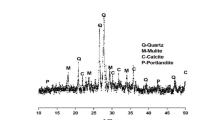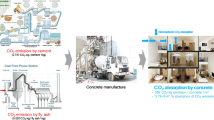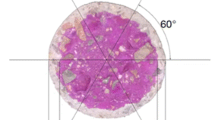Abstract
The use of fly ash (FA) for the production of new concrete seems to be a promising solution for “greening” of construction industry. However, replacement of cement with supplementary cementitious materials such as fly ash influences concrete performance especially in terms of durability. One of major durability problems worldwide is carbonation-induced corrosion, given that a large number of infrastructural objects are exposed to a CO2-rich environment. The objective of this research was to analyse the influence of cement substitution level on accelerated and natural carbonation of concrete. Experimental program considered testing of 10 concrete mixtures selected in two groups – with water to binder ratio of 0,5 (400 kg/m3 of binders) and 0,6 (300 kg/m3 of binders), while in each group the cement substitution ratio was varied from 0% to 50%. Carbonation depth was measured after 14, 21 and 28 days of exposure to 2% CO2 in carbonation chamber, while the twin samples were exposed to natural carbonation. It was shown that accelerated carbonation depths were similar in both groups for mixtures up to 30% of FA, but they were doubled and tripled for larger replacement levels. Using the previously modified fib carbonation model for service life design, the prediction of natural carbonation was made. A reliability of proposed modification was assessed by comparison between predicted and measured values of natural carbonation after 19 and 34 months of exposure.
Access this chapter
Tax calculation will be finalised at checkout
Purchases are for personal use only
Similar content being viewed by others
References
Ignjatovic, I., Carevic, V., Sas, Z., Dragas, J.: High volume fly ash concrete: Part 2: durability and radiological properties. In: Proceedings of 17th International Symposium MASE, Ohrid, North Macedonia, pp. 700–709 (2017)
Papadakis, V.G.: Effect of supplementary cementing materials on concrete resistance against carbonation and chloride ingress. Cem. Concr. Res. 30, 291–299 (2000)
Sisomphon, K., Franke, L.: Carbonation rates of concretes containing high volume of pozzolanic material. Cem. Concr. Res. 37, 1647–1653 (2007)
Jiang, L., Lin, B., Cai, Y.: A model for predicting carbonation of high-volume fly ash concrete. Cem. Concr. Res. 30, 699–702 (2000). https://doi.org/10.1016/S0008-8846(00)00227-1
Sulapha, P., Wong, S.F., Wee, T.H., Swaddiwudhipong, S.: Carbonation of concrete containing mineral admixtures. J. Mater. Civ. Eng. 15, 134–143 (2003). https://doi.org/10.1061/(ASCE)0899-1561(2003)15:2(134)
Khunthongkeaw, J., Tangtermsirikul, S., Leelawat, T.: A study on carbonation depth prediction for fly ash concrete.pdf. Constr. Build. Mater. 20, 744–753 (2006)
Ashraf, W.: Carbonation of cement-based materials: challenges and opportunities. Constr. Build. Mater. 120, 558–570 (2016). https://doi.org/10.1016/j.conbuildmat.2016.05.080
Lu, C.F., Wang, W., Li, Q.T., Hao, M., Xu, Y.: Effects of micro-environmental climate on the carbonation depth and the pH value in fly ash concrete. J. Clean. Prod. 181, 309–317 (2018). https://doi.org/10.1016/j.jclepro.2018.01.155
Atis, C.D.: Accelerated carbonation and testing of concrete made with fly ash. Constr. Build. Mater. 17, 147–152 (2003). https://doi.org/10.1016/S0950-0618(02)00116-2
Vanoutrive, H., et al.: Report of RILEM TC 281-CCC: outcomes of a round robin on the resistance to accelerated carbonation of Portland, Portland-fly ash and blast-furnace blended cements. Mater. Struct. 55(3), 1–29 (2022). https://doi.org/10.1617/s11527-022-01927-7
Tam, V.W.Y., Wang, K., Tam, C.M.: Assessing relationships among properties of demolished concrete, recycled aggregate and recycled aggregate concrete using regression analysis. J. Hazard. Mater. 152, 703–714 (2008). https://doi.org/10.1016/j.jhazmat.2007.07.061
Harrison, T.A., Khanna, G., Kandasami, S., Newlands, M.D., Jones, M.R.: Experience of using the prTS 12390–12 accelerated carbonation test to assess the relative performance of concrete. Mag. Concr. Res. 64, 737–747 (2012). https://doi.org/10.1680/macr.11.00162
fib-Model Code, Model Code 2010. Volume 2, International Federation for Structural Concrete (fib), Lausanne, Switzerland (2010)
PrCEN/TS 12390-12, Testing hardened concrete - Part 12: Determination of the potential carbonation resistance of concrete: Accelerated carbonation method
ISO 1920–12, Tessting of concrete - Part 12: Determination of the carbonation resistance of concrete - Accelerated carbonation method, 14 (2015)
Tuutti, K.: Corrosion of steel in concrete. Swedish Cement and Concrete Reasearch Institute, Stockholm, Sweden, 1982
Li, D., et al.: Evaluating the effect of external and internal factors on carbonation of existing concrete building structures. Constr. Build. Mater. 167, 73–81 (2018). https://doi.org/10.1016/j.conbuildmat.2018.01.127
Ekolu, S.O.: Model for practical prediction of natural carbonation in reinforced concrete: part 1-formulation. Cem. Concr. Compos. 86, 40–56 (2018). https://doi.org/10.1016/j.cemconcomp.2017.10.006
Wang, X.Y., Lee, H.S.: A model for predicting the carbonation depth of concrete containing low-calcium fly ash. Constr. Build. Mater. 23, 725–733 (2009). https://doi.org/10.1016/j.conbuildmat.2008.02.019
Bucher, R., Diederich, P., Escadeillas, G., Cyr, M.: Service life of metakaolin-based concrete exposed to carbonation: Comparison with blended cement containing fly ash, blast furnace slag and limestone filler. Cem. Concr. Res. 99, 18–29 (2017). https://doi.org/10.1016/j.cemconres.2017.04.013
Zhang, K., Xiao, J.: Prediction model of carbonation depth for recycled aggregate concrete. Cem. Concr. Compos. 88, 86–99 (2018). https://doi.org/10.1016/j.cemconcomp.2018.01.013
Carević, V., Ignjatović, I., Dragaš, J.: Model for practical carbonation depth prediction for high volume fly ash concrete and recycled aggregate concrete. Constr. Build. Mater. 213, 194–208 (2019). https://doi.org/10.1016/j.conbuildmat.2019.03.267
Carević, V., Ignjatović, I.: Evaluation of concrete cover depth for green concretes exposed to carbonation. Struct. Concr. (2020). https://doi.org/10.1002/suco.202000086
ASTM C618, Standard Specification for Coal Fly Ash and Raw or Calcined Natural Pozzolan for Use in Concrete, West Conshohocken, Pennsylvania (2015)
EN12390-10, Testing hardened concrete—Part 10: Determination of the relative carbonation resistance of concrete, 21 (2008)
EN 14630, Products and systems for the protection and repair of concrete structures - Test methods - Determination of carbonation depth in hardened concrete by the phenolphthalein method, 8 (2006)
EN 206, Concrete - Specification, performance, production and conformity (2013)
Acknowledgements
This work was supported by the Ministry for Education, Science and Technology, Republic of Serbia [grant number 200092]. The authors gratefully thank to master students – Edin Čavić, Maša Milovanović and Nikola Knežević for their significant contribution to conducted experimental work.
Author information
Authors and Affiliations
Corresponding author
Editor information
Editors and Affiliations
Rights and permissions
Copyright information
© 2023 The Author(s), under exclusive license to Springer Nature Switzerland AG
About this paper
Cite this paper
Carević, V., Radević, A., Ignjatović, I. (2023). Influence of Fly Ash as Cement Substitution on Accelerated and Natural Carbonation of Concrete. In: Jędrzejewska, A., Kanavaris, F., Azenha, M., Benboudjema, F., Schlicke, D. (eds) International RILEM Conference on Synergising Expertise towards Sustainability and Robustness of Cement-based Materials and Concrete Structures. SynerCrete 2023. RILEM Bookseries, vol 44. Springer, Cham. https://doi.org/10.1007/978-3-031-33187-9_106
Download citation
DOI: https://doi.org/10.1007/978-3-031-33187-9_106
Published:
Publisher Name: Springer, Cham
Print ISBN: 978-3-031-33186-2
Online ISBN: 978-3-031-33187-9
eBook Packages: EngineeringEngineering (R0)




